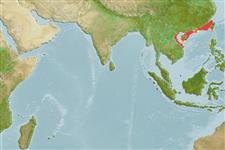Lớp phụ Cá sụn (cá mập và cá đuối) (sharks and rays) >
Torpediniformes (Electric rays) >
Platyrhinidae (Fanrays)
Etymology: Platyrhina: Greek, platys = flat + Greek, rhinos = nose. It is the same voice used for the Mammalian division made in Primates (Ref. 45335).
More on authors: Bloch & Schneider.
Environment: milieu / climate zone / depth range / distribution range
Sinh thái học
Biển gần đáy; Ở đại duơng, biển (Ref. 51243). Subtropical; 25°N - 15°N, 105°E - 120°E (Ref. 114953)
Northwest Pacific: Chinese coast of Taiwan Strait and in the South China Sea to northern Vietnamese waters; not confirmed from Japanese, South Korean or Taiwanese waters (likely to occur in Taiwan).
Bộ gần gũi / Khối lượng (Trọng lượng) / Age
Maturity: Lm ? range ? - ? cm
Max length : 86.3 cm TL con đực/không giới tính; (Ref. 83530); common length : 50.0 cm TL con đực/không giới tính; (Ref. 637)
This species is distinguished from its congeners in having the following set of characters: two rows of thorns (strongly hooked and gradually becoming somewhat embedded toward first dorsal fin origin) on mid-dorsum of tail; no thorns at the anterior part of scapular region; thorns on the orbital, nape and scapular regions not encircled by light yellow or white pigment; dorsal surface covered with minute dermal denticles of uniform size and shape, no obvious larger dermal denticles (smooth to touch) (Ref. 86259).
Found inshore (Ref. 9903), above 60 m on rock or rocky sand bottoms (Ref. 11230). Ovoviviparous (Ref. 50449). Biology little known (Ref. 9903).
Life cycle and mating behavior
Chín muồi sinh dục | Sự tái sinh sản | Đẻ trứng | Các trứng | Sự sinh sản | Ấu trùng
Exhibit ovoviparity (aplacental viviparity), with embryos feeding initially on yolk, then receiving additional nourishment from the mother by indirect absorption of uterine fluid enriched with mucus, fat or protein through specialised structures (Ref. 50449).
Compagno, L.J.V. and P.R. Last, 1999. Platyrhinidae. Thornback rays. p. 1431-1432. In K.E. Carpenter and V.H. Niem (eds.) FAO identification guide for fishery purposes. The living marine resources of the Western Central Pacific. Rome, FAO. (Ref. 9903)
IUCN Red List Status (Ref. 130435)
Human uses
Thêm thông tin
Các tài liệu tham khảoNuôi trồng thủy sảnTổng quan nuôi trồng thủy sảnCác giốngDi truyềnElectrophoresesDi sảnCác bệnhChế biếnNutrientsMass conversion
Các công cụ
Special reports
Download XML
Các nguồn internet
Estimates based on models
Preferred temperature (Ref.
123201): 22.8 - 26.7, mean 25.2 °C (based on 112 cells).
Phylogenetic diversity index (Ref.
82804): PD
50 = 0.6250 [Uniqueness, from 0.5 = low to 2.0 = high].
Bayesian length-weight: a=0.01000 (0.00244 - 0.04107), b=3.04 (2.81 - 3.27), in cm total length, based on all LWR estimates for this body shape (Ref.
93245).
Mức dinh dưỡng (Ref.
69278): 3.5 ±0.37 se; based on food items.
Thích nghi nhanh (Ref.
120179): thấp, thời gian nhân đôi của chủng quần tối thiểu là 4.5 - 14 năm (Fec assumed to be <100).
Fishing Vulnerability (Ref.
59153): Moderate to high vulnerability (55 of 100).
